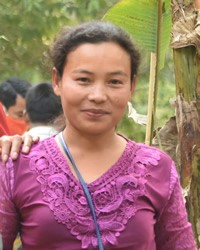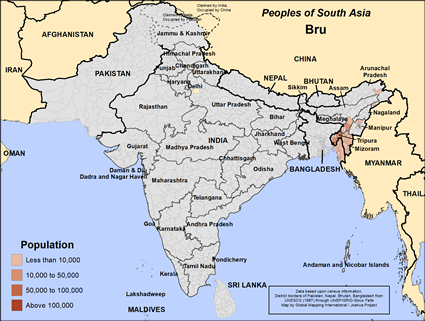Bru in Bangladesh

Photo Source:
Jonom Bru - Pixabay
|

Map Source:
People Group data: Omid. Map geography: UNESCO / GMI. Map Design: Joshua Project
|
| People Name: | Bru |
| Country: | Bangladesh |
| 10/40 Window: | Yes |
| Population: | 2,400 |
| World Population: | 210,400 |
| Primary Language: | Riang |
| Primary Religion: | Hinduism |
| Christian Adherents: | 14.19 % |
| Evangelicals: | 0.00 % |
| Scripture: | Complete Bible |
| Ministry Resources: | Yes |
| Jesus Film: | Yes |
| Audio Recordings: | Yes |
| People Cluster: | South Asia Tribal - other |
| Affinity Bloc: | South Asian Peoples |
| Progress Level: |
|
Introduction / History
Within Bangladesh the Bru people live almost exclusively in Rangamati district of the Chittagong Hill Tracts. Ethnically they relate loosely with the Tripura community, which spreads through much of the Hill Tracts in Bangladesh, through Tripura state, India, and into southern Sylhet division, which is again in Bangladesh. Riang is the heart language of the Bru people in Bangladesh.
What Are Their Lives Like?
The language situation among the Bru in Bangladesh is an interesting one. There are thousands of Bru people in Rangamati district, but only a small number still speak Riang. Most of the other Bru people in Bangladesh now speak a form of Chakma as their mother tongue. Still, it is uncommon for Tripura and Chakma to marry each other, indicating that there is still a significant distinction between the two groups. In Bangladesh most Riang speakers are agriculturalists, and they practice a type of farming which is often referred to as "slash and burn" farming. They live in hilly areas and farm different hillsides on a rotational basis. Their homes are generally made of bamboo and leaves, and most of their villages do not have electricity or roads leading to them.
What Are Their Beliefs?
The Bru generally follow the Sonaton religion, but today a significant percentage of Riang speakers in Bangladesh have become Christian. Because Riang church leaders have had minimal training, Bru Christians could benefit from a discipleship ministry. Also, the Riang in general could benefit from evangelistic and community development missions work.
What Are Their Needs?
Because of the distance to schools and the Bru ‘s lack of ability in Bangla the medium of education in government schools most Bru remain fairly uneducated.
Prayer Points
Pray for Bru culture to be renewed and enhanced by a work of the Holy Spirit and shaped into a God-centered and God-honoring mold.
Pray for the Holy Spirit to move among Bru family and community leaders to seek His face and enjoy his blessings.
Pray for the Lord to thrust out workers who will be compelled to nurture a Disciple Making Movement among the Bru people.
Pray that soon the Bru people will have faith that will lead them to live honorable lives that will draw others to the savior.